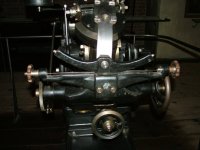I have done an acceptable bevel gear on a shaper. The 1940s Mark's Handbook I read said it simply couldn't be done. I had seen bevel gears on 120yr old machines that had marks at the end of the tooth that were obviously cut on a horizontal mill and I KNEW not every machine shop at that time had access to a Gleason gear shaper, so there was a way to do it.
Had to get a 1927 Colvin and Stanley Machinist's Handbook to get the details of how it was done on a horizontal mill and then reverse engineer the process. You use a typical involute gear cutter, but the one you select is for a much finer tooth count than for a spur gear. There is a fair amount of mathematical calculations you go into to get the bevel angle and all that determined, then the work is set up in a dividing head, at that angle. You get the center of your disc, then step the table off center a given amount, more than for a typical spur gear, then roll the work in the dividing head towards the cutter a certain number of divisions. Then you make your cut and index the rest around at the same setting.
I hand ground a shaper bit using a template and blued the HSS with ink, then scribed the shape with a diamond scribe. Ground the bit with clearance until no light on my template. Set up the shaper exactly as described for the horizontal mill. I think it was a 12 or 16hr job (it's been almost 20 years ago), but the end yielded a functional 35 tooth 5" diam bevel gear that engaged and ran in the head of a big 100+ yr old radial drill.
Whole point being, there are ways to do it, but it is a LONG complicated and slow process. The tooth form cut this way is not perfect in form and would be very short lived at high speeds and heavy loads, but for something like this feed tumbler, it would indeed work for decades, and it is probably how that gear was made originally. If you see V shaped cuts on the tube at the small end of the teeth, that's exactly how it was made.





 ) Thanks for writing.
) Thanks for writing.



